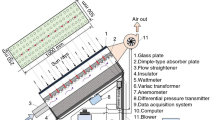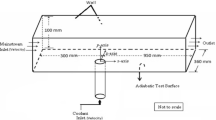Abstract
In this paper, finned type heat exchangers with different fin dimensions in the exhaust of a gasoline engine are modeled numerically for improving the exhaust energy recovery. RNG k-ε viscous model is used and the results are compared with available experimental data presented by Lee and Bae (Int J Therm Sci 47:468–478, 2008) where a good agreement is observed. Also, the effect of fin numbers, fin length and three water-based nanofluid coolants (TiO2, Fe2O3 and CuO) on the heat recovery efficiency are investigated in different engine loads. As a main outcome, results show that increasing the fin numbers and using TiO2-water as cold fluid are the most effective methods for heat recover. Furthermore, an optimization analysis is performed to find the best fins dimensions using response surface methodology.














Similar content being viewed by others
References
Saidur R, Rahim NA, Ping HW, Jahirul MI, Mekhilef S, Masjuki HH (2009) Energy and emission analysis for industrial motors in Malaysia. Energy Policy 37(9):3650–3658
Hasanuzzaman M, Rahim NA, Saidur R, Kazi SN (2011) Energy savings and emissions reductions for rewinding and replacement of industrial motor. Energy 36(1):233–240
Ghazikhani M, Hatami M, Safari B (2014) The effect of alcoholic fuel additives on exergy parameters and emissions in a two stroke gasoline engine. Arab J Sci Eng. doi:10.1007/s13369-013-0738-3
Ghazikhani M, Hatami M, Safari B (2014) Effect of speed and load on exergy recovery in a water-cooled two stroke gasoline-ethanol engine for the bsfc reduction purposes, Scientia Iranica, in press, 2014
Kiwan S, Al-Nimr M (2001) Using porous fins for heat transfer enhancement. ASME J Heat Transf 123:2001
Kiwan S (2007) Effect of radiative losses on the heat transfer from porous fins. Int J Therm Sci 46:1046–1055
Hatami M, Ganji DD (2013) Thermal performance of circular convective-radiative porous fins with different section shapes and materials. Energy Convers Manag 76:185–193
Hatami M, Hasanpour A, Ganji DD (2013) Heat transfer study through porous fins (Si3N4 and AL) with temperature-dependent heat generation. Energy Convers Manag 74:9–16
Hatami M, Ganji DD (2014) Thermal and flow analysis of microchannel heat sink (MCHS) cooled by Cu–water nanofluid using porous media approach and least square method. Energy Convers Manag 78:347–358
Ghazikhani M, Hatami M, Ganji DD, Gorji-Bandpy M, Shahi Gh, Behravan A (2014) Exergy recovery from the exhaust cooling in a DI diesel engine for BSFC reduction purposes. Energy 65:44–51
Pandiyarajan V, Chinna Pandian M, Malan E, Velraj R, Seeniraj RV (2011) Experimental investigation on heat recovery from diesel engine exhaust using finned shell and tube heat exchanger and thermal storage system. Appl Energy 88:77–87
Lee S, Bae C (2008) Design of a heat exchanger to reduce the exhaust temperature in a spark-ignition engine. Int J Therm Sci 47:468–478
Zhang HG, Wang EH, Fan BY (2013) Heat transfer analysis of a finned-tube evaporator for engine exhaust heat recovery. Energy Convers Manag 65:438–447
Hossain SN, Bari S (2013) Waste heat recovery from the exhaust of a diesel generator using Rankine cycle. Energy Convers Manag 75:141–151
B S, Hossain SN (2013) Waste heat recovery from a diesel engine using shell and tube heat exchanger. Appl Therm Eng 61:355–363
Reid RC, Prausnitz JM, Poling BE (1987) The properties of gases and liquids, 4th edn. McGraw-Hill, New York
Peyghambarzadeh SM, Hashemabadi SH, Seifi Jamnani M, Hoseini SM (2011) Improving the cooling performance of automobile radiator with Al2O3/water nanofluid. Appl Therm Eng 31:1833–1838
Leong KY, Saidur R, Kazi SN, Mamun AH (2010) Performance investigation of an automotive car radiator operated with nanofluid-based coolants (nanofluid as a coolant in a radiator). Appl Therm Eng 30:2685–2692
Hatami M, Ganji DD (2014) Thermal and flow analysis of microchannel heat sink (MCHS) cooled by Cu–water nanofluid using porous media approach and least square method. Energy Convers Manag 78:347–358
Hatami M, Ganji DD (2013) Heat transfer and flow analysis for SA-TiO2 non-Newtonian nanofluid passing through the porous media between two coaxial cylinders. J Mol Liquids 188:155–161
Hatami M, Nouri R, Ganji DD (2013) Forced convection analysis for MHD Al2O3–water nanofluid flow over a horizontal plate. J Mol Liquids 187:294–301
Hatami M, Ganji DD (2014) Heat transfer and nanofluid flow in suction and blowing process between parallel disks in presence of variable magnetic field. J Mol Liquids 190:159–168
Domairry G, Hatami M (2014) Squeezing Cu–water nanofluid flow analysis between parallel plates by DTM-Padé Method. J Mol Liquids 193:37–44
Ahmadi AR, Zahmatkesh A, Hatami M, Ganji DD (2014) A comprehensive analysis of the flow and heat transfer for a nanofluid over an unsteady stretching flat plate. Powder Technol 258:125–133
FLUENT 6.3 user’s guide (2006) FLUENT Inc., New York
Bilirgen Harun, Dunbar S, Levy EK (2013) Numerical modeling of finned heat exchangers. Appl Therm Eng 61:278–288
Rabienataj Darzi AA, Farhadi M, Sedighi K (2013) Heat transfer and flow characteristics of Al2O3–water nanofluid in a double tube heat exchanger. Int Commun Heat Mass Transf 47:105–112
Perry RH (1984) Perry’s Chemical Engineers’ Handbook, 6th edn. McGraw-Hill, New York
Patankar SV (ed) (1980) Numerical Heat Transfer and Fluid Flow. McGrawHill, NewYork
Aslan N (2007) Application of response surface methodology and central composite rotatable design for modeling the influence of some operating variables of a Multi-Gravity Separator for coal cleaning. Fuel 86:769–776
Sun Lei, Zhang Chun-Lu (2014) Evaluation of elliptical finned-tube heat exchanger performance using CFD and response surface methodology. Int J Therm Sci 75:45–53
Hatami M, Ganji DD, Gorji-Bandpy M (2014) A review of different heat exchangers designs for increasing the diesel exhaust waste heat recovery. Renew Sustain Energy Rev 37:168–181
Hatami M, Ganji DD, Gorji-Bandpy M (2014) Numerical study of finned type heat exchangers for ICEs exhaust waste heat recovery. Case Stud Therm Eng. doi:10.1016/j.csite.2014.07.002
Mokkapati V, Lin C-S (2014) Numerical study of an exhaust heat recovery system using corrugated tube heat exchanger with twisted tape inserts. Int Commun Heat Mass Transf. http://dx.doi.org/10.1016/j.icheatmasstransfer.2014.07.002
Acknowledgments
The authors gratefully acknowledge the respected reviewers for their helpful comments and suggestions. Also, first author (M. Hatami) sincerely appreciates Dr. S. Lee for the experimental data presented in Ref. [12] and his constructive and scientific guidance for validating the results.
Author information
Authors and Affiliations
Corresponding author
Rights and permissions
About this article
Cite this article
Hatami, M., Ganji, D.D. & Gorji-Bandpy, M. CFD simulation and optimization of ICEs exhaust heat recovery using different coolants and fin dimensions in heat exchanger. Neural Comput & Applic 25, 2079–2090 (2014). https://doi.org/10.1007/s00521-014-1695-9
Received:
Accepted:
Published:
Issue Date:
DOI: https://doi.org/10.1007/s00521-014-1695-9




